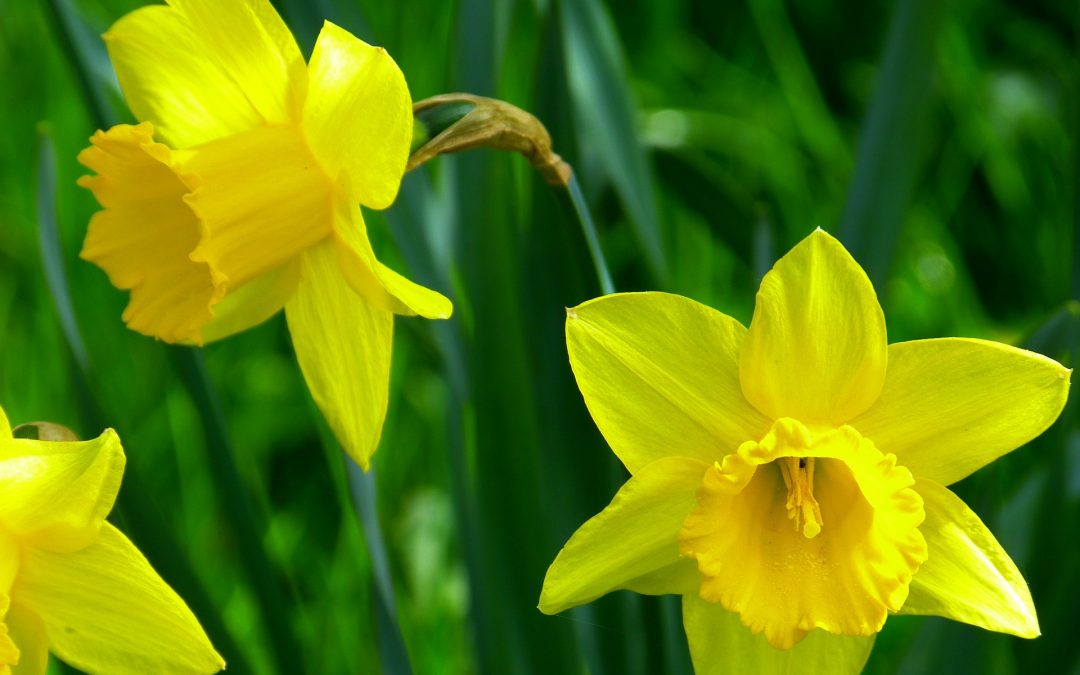We’re so excited to have launched our lovely new candle, Narcissus. The fresh and spring-like fragrance is inspired by the Marie Curie charity’s famous flower symbol, and we’re selling it to raise money for this wonderful cause.
To celebrate the new candle and reed diffuser, here’s a look at the beautiful flower behind both the fragrance and the charity’s emblem, the narcissus, or daffodil.
They’re named after an ancient Greek myth
Daffodil is the common name for the genus Narcissus, of which there are now thousands of different varieties and hybrid species. In the Greek myth, a man named Narcissus gazed at his refection in a pool, and was literally transfixed by his own good looks. He became rooted to the spot, as a daffodil. We also get the term “narcissist” from this tale. The more common name of daffodil comes from “asphodel”, which is a completely different flower, and there’s a theory that the names became confused when the bulbs of both were imported from Holland. The correct name for the flower’s distinctive central trumpet is “corona” but frankly, the less said about that the better…
The Romans brought them to Britain
Daffodils were cultivated in Ancient Greece and Rome (200-300 BC). The Romans brought them to Britannia with them, and because daffodils don’t mind a bit of cold and damp, they soon flourished in their new home. Why did the Romans bring daffodils with them? Their use isn’t as immediately obvious as say, plumbing, turnips or wine. The Romans actually used daffodil sap to treat wounds, which is why they wanted to introduce them here. (Daffodil sap is actually a poisonous irritant, so would have made their wounds worse. But hey – we’re glad they brought the flower!)
They’re the symbol of Wales
Correction: they’re one of the symbols of Wales. The leek is the original official emblem; however in the 19th-century, a flower was considered more attractive (and certainly better smelling) than a vegetable. A daffodil may have been chosen due to linguistic confusion: a leek is cenhenin, a daff is cenhenin Pedr (literally Peter’s leek). So, the symbol of Wales is a Roman flower, possibly chosen by accident. Wearing a daffodil on St David’s Day was popularised by the Welsh PM, David Lloyd George.
The world’s biggest daffodil farm is in Cornwall
Daffodils were first grown commercially on the Isles of Scilly in the 1870s, when potato farmer William Trevellick made two realisations: the narcissi that grew wild around his farm were beautiful, and that thanks to the regular ferry and train service, he could get daffs to London within 48 hours of picking them. Today, the world’s largest daffodil farm is just outside Penzance in West Cornwall, and it produces 500 million flowers each year. Although they came from warmer climes, daffodils do well in the Cornish climate. The bulbs actually need 12 weeks of cold to activate them and, if kept healthy, will bloom annually for years, even decades.
They’re poisonous
You really don’t want to eat a daffodil. The sap is poisonous, and this is the reason why other flowers will quickly die if you pop daffodils in the vase with them. There’s a way round this: soak the daffodil in water for 24 hours before adding it to the other blooms. However, as with many other poisonous plants, there’s a hidden health benefit, and daffodils are used in treatment for Alzheimer’s. There’s an alkaloid called galantamine found in daffodils that can help with vascular memory impairment.
Daffodils are a lucky gift
Despite being poisonous daffodils represent cheerfulness and friendship. Gifting someone with a bunch of daffodils (or ahem, a narcissus candle…) will bring them luck and happiness. However, a single daffodil will have the opposite effect and is considered unlucky. They’re the symbol of the New Year in China; and in Wales, whoever sees the first daffodil of the season will have good luck. They’re the traditional flower for the 10th wedding anniversary; if this doesn’t fall in the spring, think about gifting some daffodil bulbs instead (or again, a candle).
Daffodils symbolise hope and renewal
This is why Marie Curie chose the daffodil for the charity’s symbol. The charity’s website explains why:
Daffodil flowers begin to pop up when winter ends. They’re a symbol of spring and symbolise new beginnings and rebirth. They’re a positive, life-affirming symbol, with a bright and joyful yellow colour. Daffodils are strong, resilient flowers that pop up year after year. Some people choose to plant daffodils in memory of their loved ones. This can bring reassurance and comfort.
We think that’s beautiful.
If you would like to support this incredible charity, please buy our new Narcissus scented candle or reed diffuser. For each candle we sell, we will donate £9 to Marie Curie, and £12 for each reed diffuser. Thank you for your support x


